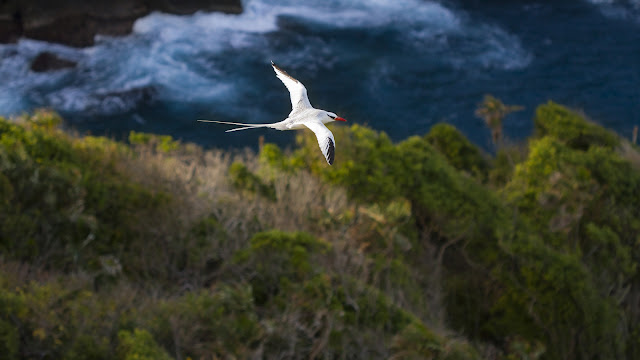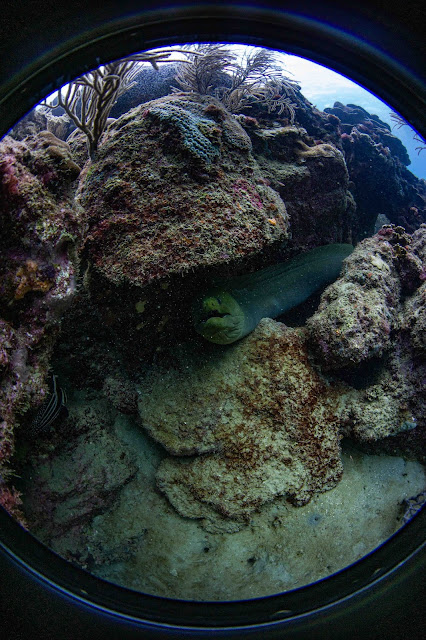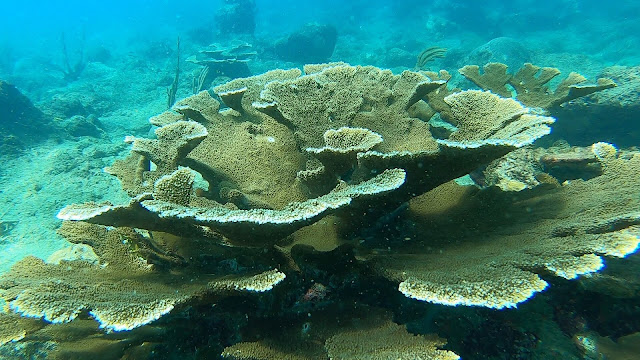Colourful Creatures of Coral Reefs
Dr Anjani Ganase, coral reef ecologist presents some of the residents of coral reefs.
Our view of the world is limited to what we can see, what we have learned to see. Let us expand that view to some of the creatures in the marine world. Here, many colours, patterns, projections and textures of the tiniest of creatures have evolved for an ecological purpose and for survival. This Christmas, I present the beautiful and colourful marine mini creatures of our coral reefs. They may be invisible to us and occupy tiny spaces but they contribute to the marvellous marine web and the life of the whole planet. And yes, to our existence. Many are named for things that we see on land because these creatures bear some slight resemblance to something familiar.

Christmas tree worms on brain
coral. Credit: Nico Marin / Ocean Image Bank
Christmas tree worms
They look like tiny Christmas trees with an ornate display of colourful branches covered in cilia for feeding on debris that drift by and for oxygen exchange. Christmas tree worms come in many colours. If a predator or a diver approaches too closely, the worm will quickly protract revealing a defensive barb. Christmas tree worms often bore into the skeleton of corals and rock and will remain in one location for its entire life. Scientists found that Christmas tree worms can live as long as 40 years based on the growth rings of its casing.

Pygmy seahorse. Credit: David P.
Robinson / Ocean Image Bank
The Pygmy seahorse (Hippocampus bargibanti)
Occurring only to the Indo-West Pacific, this fish only grows up to 2.7 cm in length. It is completely adapted to resemble the gorgonians sea fans they inhabit. Poor swimmers they do not roam very far along the reefs. Bargibant’s pygmy seahorses, in particular, are able to change their colours to take the colour of the gorgonians they reside on. Pygmy seahorses occur between 16 - 40 m in depth and form monogamous pairs for breeding. Like pipefish, the male seahorses carry their young in a pouch located on its trunk. They feed on drifting plankton.

Zoanthus coral ultraviolet macro.
Credit: Ramona Osche / Ocean Image Bank
Zoanthids
Zoanthids are a close relative of coral and jellyfish. In fact, they can acquire their bright colours in the same way corals do through symbiosis with zooxanthellae, symbiotic algae that live in their tissues. The algae photosynthesises and provides its zoanthid host with nutrient, but the zoanthid can also capture planktonic prey. The colourful species are an aquarist’s delight creating colourful displays, especially under UV light. The colour displays of zoanthids are nearly endless, but as pretty as they are, they must be handled with care as they are toxic and a risk to aquarists. Some speculate that their bright colours serve as a warning to predators.

Nudibranch Credit: Grant Thomas /
Ocean Image Bank
Nudibranchs
Coryphelina nudibranchs are one example of the rich diversity of these organisms across tropical oceans. Nudibranchs are similar to the slugs found in your backyard. While some have adapted their morphology to camouflage, others have adapted to do the opposite. Instead, they incorporate toxic and brightly coloured pigments into their tissues. The vibrant display - like a carnival masquerader – serves to ward off predators. Some nudibranchs are capable of incorporating algal symbionts, similar to corals, which makes them solar powered. All nudibranchs are hermaphroditic, meaning they have both male and female parts. During mating, nudibranchs battle each other with their sword penises and the nudibranch that is able to pierce the other with their penis can impregnate it with its sperm. After mating the nudibranch will cast off their penis and grow another for further mating.

Goby on Brain coral. Credit: Connor
Holland / Ocean Image Bank
Coral-dwelling gobies
Miniature guardians of corals, gobies form tiny homes in the skeleton of the coral. The goby protects the corals by removing unwanted algae, and deterring predation. When algae grows on the coral, it will release a chemical that will signal the goby to remove it or graze on it. When a damselfish comes around to predate the coral, the goby will produce a deterrent chemical to drive the damselfish away. Some research also suggests that gobies and other commensal fish that live in corals help reduce bleaching impacts in corals as their movement over the coral polyps encourage water circulation.

Flamingo Tongue. Credit: Connor
Holland / Ocean Image Bank
Flamingo Tongue
The Flamingo tongue is the exotic name given to a marine snail found in the western Atlantic Ocean. The origin of the name is not known and it clearly does not resemble a flamingo tongue. Given its location in the Americas, an alternative suggestion online is the Jaguar snail for its spotted pattern. Their colourful skin wraps around the exterior of the shell. Similar to the nudibranchs, Flamingo Tongues can graze on soft corals, and incorporate stinging cells or toxins into their bodies and display bright colours to ward off predators. There is more than one species in the region and they are closely related to cowries. These snails can be found as deep as 30 m.
 |
| Urchin spines Credit: Hannes Klostermann / Ocean Image Bank |
Sea urchins
There are over 900 species of sea urchins, which come in many shapes, colours, and sizes. Some urchins have long thin spines, while other have short stubby spines. A closer look at the sea urchin reveals a dazzling body of colours. Sea urchins are radially symmetrical and are found on the ocean floor. The mouth is located below the body and grazes benthic surfaces as it moves around. Many species of urchins have an Aristotle’s lantern which is a depression where the mouth occurs and used for scraping and injecting food, while there is a balloon projected from the top of the sea urchin called the anal cone used for waste removal. The spines of urchins serve as a deterrent to predation, but some animals do enjoy feeding on sea urchins, including triggerfish and lobsters.
Many of these marine creatures, despite having toxic tissues, are important food for larger fish and invertebrates living on coral reefs. Without the large predators to keep the coral reef food web in check, these little critters can run amok and infect corals, sponges and algae. They are an important indicator of a reef in balance. These tiny marine critters draw SCUBA divers from all over the world who come to coral reefs just to view them in their habitat. They serve as tourism boosts with significant economic benefits, and communities who know this, take time to learn about the biology, where they occur and how to protect them.


